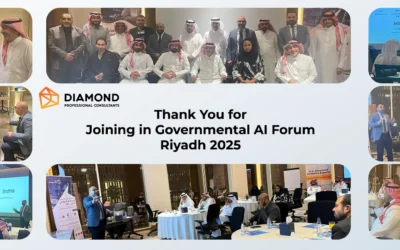The Day Big Tech Woke Up.
Not long ago, the AI-driven world seemed locked in a race dominated by the tech giants. OpenAI, Google (Gemini), and Meta invested billions of dollars into training AI models that only they could afford. The common belief was that the best AI required massive investments in computing power — if you don’t have the capital, you’re not in the AI race.
Hatem Elkady [CEO of Diamond Professional Consultants], sees this moment as pivotal:
“For too long, AI has been a game of capital. But DeepSeek is proof that smart engineering can level the playing field. Businesses must stop thinking of AI as a ‘luxury for the biggest firms’ and start recognizing that agility, not size, will define the next era of AI.”Then came DeepSeek.
Last week DeepSeek introduced its DeepSeek-V3/R1 model. It wasn’t just that they had built an AI model as powerful as OpenAI’s latest GPT—the real shock was how they did it: using a fraction of the resources. DeepSeek spent an estimated $6 millionin computing power—compared to the hundreds of millions spent by OpenAI and other competitors to train AI Models.
The stock market reacted instantly. The “DeepSeek selloff” saw investors scrambling, shaken by the idea that AI supremacy was no longer guaranteed for Silicon Valley’s biggest names.
For years, OpenAI, Google, and Meta dictated the pace of AI progress. Their assumption? That no one outside their ecosystem could match their scale. DeepSeek shattered that illusion.
This wasn’t just a technological breakthrough. It was a warning shot to Big Tech. The AI war race was no longer limited to those with billion-dollar war chests. Now the question big tech giants should ask:
What happens when smaller players, armed with smarter strategies, begin to outperform giants?
DeepSeek and Moore’s Law: A New Era of AI Efficiency.

Everything’s getting faster and cheaper these days— and you can sense it now with the recent breakthrough of the Deepseek V3/R1 Model. For years, the dominant belief in AI was that bigger always meant better—larger datasets, more GPUs, and billion-dollar investments were necessary to build top-tier AI models. But DeepSeek proves that being “mini but mighty”is just as powerful.
Moore’s Law is the concept that computing power – gets faster, smaller, and more efficient over time. This law has shaped the tech industry for decades. But DeepSeek’s breakthrough suggests we may be entering a post-Moore’s Law era for AI — How?
By training its model on significantly fewer GPUs, DeepSeek has disrupted the notion that only tech giants with endless budgets can compete in the AI space. This raises a new question for business leaders:
Smaller, well-optimized models can outperform their larger counterparts, making AI more accessible to businesses of all sizes. The next generation of AI will not be defined by who has the most computing power, but by who can achieve the best results with fewer resources.
Anas Elkhatib 🇵🇸, [Director AI Analytics], of Diamond Professional Consultants shares his thoughts:
The recent Deepseek R1 model shows that enterprises don’t need billion-dollar AI labs to compete. Instead, they need the right approach—one focused on agility, efficiency, and intelligent execution.Andrew Ng’s Take on AI Disruption Landscape.
Andrew Ng, one of the most influential AI thinkers of our time, recently reflected on the impact of DeepSeek, saying:
“Today’s ‘DeepSeek selloff’ in the stock market shows how much disruption DeepSeek V3/R1 is causing in the tech world. While competition is intense in building foundational technologies (like AI models), this is actually great news for companies focused on building useful applications on top of these technologies. The competition pushes innovation at the core, creating better tools for app builders to thrive.”
His insight is crucial. While the focus is often on which AI model is the best, the true disruption is happening in how AI models enable real-world applications. Businesses that understand this shift—leveraging AI not just as a buzzword but as a tool for real transformation—will be the ones that thrive.
Use AI to Build Something Concrete.
Companies should focus on creating AI applications that solve real-world problems. Instead of chasing AI hype, the approach for AI startups and enterprises alike: Don’t just build AI for AI’s sake—build AI that delivers tangible value.
Too often, AI development focuses on flashy capabilities with little application. One of the biggest tests of AI’s usefulnessis whether a company can define its product vision in detail so that an engineering team can build a prototype.
The AI industry’s most successful disruptors are those who prioritize function over hype!
The Importance of an Open Ecosystem.
Right now, most companies training large language models are locked into business models that encourage a closed approach. DeepSeek and Meta present an opportunity for a more open AI ecosystem—one where companies share advancements rather than hoarding them.
If more AI firms follow this path, we could see an industry where innovation is driven by collective improvement rather than exclusivity. Open ecosystems promote faster innovation, better standards, and wider AI accessibility.
The Future Cost of AI Training: A Ticking Clock?

According to Epoch AI, while the cost of training AI models is currently high and rapidly increasing, it will decrease in the future due to advancements in hardware, software optimization, and more efficient training techniques.
However, they also warn that a potential data shortage could limit this decrease and even cause costs to rise if high-quality training data becomes scarce.
This presents a critical challenge: AI companies must not only innovate on computation efficiency but also rethink how they gather and utilize data.
The Playbook for Disrupting Giants.
For decision-makers—CFOs, CIOs, and AI strategists—the DeepSeek moment should serve as a blueprint for disruption. Here’s what we can learn:
🔆 Efficiency Beats Scale – The belief that bigger budgets create better AI is flawed. Smart optimization can yield equal (or superior) results at a fraction of the cost. The next AI revolution will come from companies that prioritize efficiency overspending.
🔆 Big Tech’s AI Monopoly is Cracking – The idea that AI breakthroughs can only come from Silicon Valley is now outdated. The next wave of innovation will come from places where necessity breeds smarter solutions—China, the Middle East, and beyond.
🔆 Decentralization is the Future – AI’s future isn’t owned by a handful of corporations. DeepSeek’s approach proves that smaller, agile teams can compete. For enterprises, this means partnerships with emerging AI firms may be just as valuable as those with tech giants.
🔆 If you’re a CFO making budget decisions on AI adoption, or a CIO planning your company’s next move in digital transformation, the lesson is clear:
Don’t wait for the next OpenAI model to dictate your strategy.
China’s AI Ambition: A Global Shift in Power.

The rise of DeepSeek isn’t just about technology; it’s about geopolitics, innovation strategy, and the global balance of power in AI. China’s rapid advancements in AI, despite US chip export restrictions, signal that the AI race is no longer dominated by Silicon Valley alone.
As Ian Bremmer [American political scientist], highlighted in The Power of Crisis:
The U.S. and China have “too much to lose from catastrophic collision” in tech warfare. But what we’re seeing isn’t just competition—it’s a reshaping of the AI landscape, one where companies and countries that adapt quickly will lead the next wave of innovation.
For CIOs, CFOs, and business leaders, this isn’t just a distant geopolitical debate—it’s a call to action. AI is no longer an exclusive game for trillion-dollar tech giants.
The next disruptive technology may not come from where you expect it!
The Takeaway: The AI Revolution is Open for Business.
DeepSeek’s disruption of AI isn’t just about one company’s breakthrough—it’s about what comes next. The AI industry is shifting from a monopoly of a few to an ecosystem of many. Businesses that embrace this shift will be the ones that win.
The question isn’t whether Big Tech will be disrupted—it already is. The question is: Who will be the next to capitalize on this moment?
What’s your take? Is AI’s future in the hands of smaller, leaner players? Share your thoughts in the comments!
Get Started with AI Today!
💬 Contact us today: hello@diamond-dpc.com
📱 Call: +202 383 614 87 | Mobile: +2011 522 722 29
🌐 Visit us at: Diamond-DPC.com





